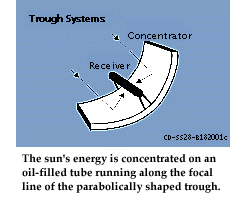 Many commercial systems now use something called a parabolic trough: Here the focus point of the parabolic trough is a receiver pipe. The pipe is filled
with oil (not crude oil) and is heated to about 400 C. This heat energy is then used to
generate electricity in a conventional steam generator. Solar trough farms are now being constructed (at a slow pace) in some locations in the American SW. The Nevada Solar One: plant is a good example of a small scale project Many commercial systems now use something called a parabolic trough: Here the focus point of the parabolic trough is a receiver pipe. The pipe is filled
with oil (not crude oil) and is heated to about 400 C. This heat energy is then used to
generate electricity in a conventional steam generator. Solar trough farms are now being constructed (at a slow pace) in some locations in the American SW. The Nevada Solar One: plant is a good example of a small scale project
We can use the details of construction of Nevada Solar One as a model to scale from:
- Output = 64 MW
- Cost = $266 million = $4.15 per watt (remember wind is 1.5-1.7 $/watt)
- Project footprint: 400 acres = 40 MW per square km
- 28 jobs created = 2.2 Jobs per MW
- Construction time line = 16 months = 4 MW per month
All renewable energy projects need to be evaluate in the units just presented!
Now let imagine scaling this up by a factor of 10 to 640 MW to serve Eugene.
What kind of footprint would that have in say a sunny location in Eastern
Oregon?



What would be required to do this?
- 2.7 Billion dollars (high up fronr cost)
- 280 workers
If this facility had a 30 year lifetime, then that 2.7 billion dollar sticker shock is really $90 million dollars a yeaar for 30 years. Oregon already spends about 1 Billion dollars a year on core infrastructure projects so this is a drop in the bucket.
Suppose you wanted to put the project cost entirely on Eugene
residents. According to EWEB there are about 75,000 residential customers in Eugene. That translates into $1200 per year per residence to build this facility (from which each residence would
get "free" electricity during the day time).
| 
 Many commercial systems now use something called a parabolic trough: Here the focus point of the parabolic trough is a receiver pipe. The pipe is filled
with oil (not crude oil) and is heated to about 400 C. This heat energy is then used to
generate electricity in a conventional steam generator. Solar trough farms are now being constructed (at a slow pace) in some locations in the American SW. The
Many commercial systems now use something called a parabolic trough: Here the focus point of the parabolic trough is a receiver pipe. The pipe is filled
with oil (not crude oil) and is heated to about 400 C. This heat energy is then used to
generate electricity in a conventional steam generator. Solar trough farms are now being constructed (at a slow pace) in some locations in the American SW. The 
